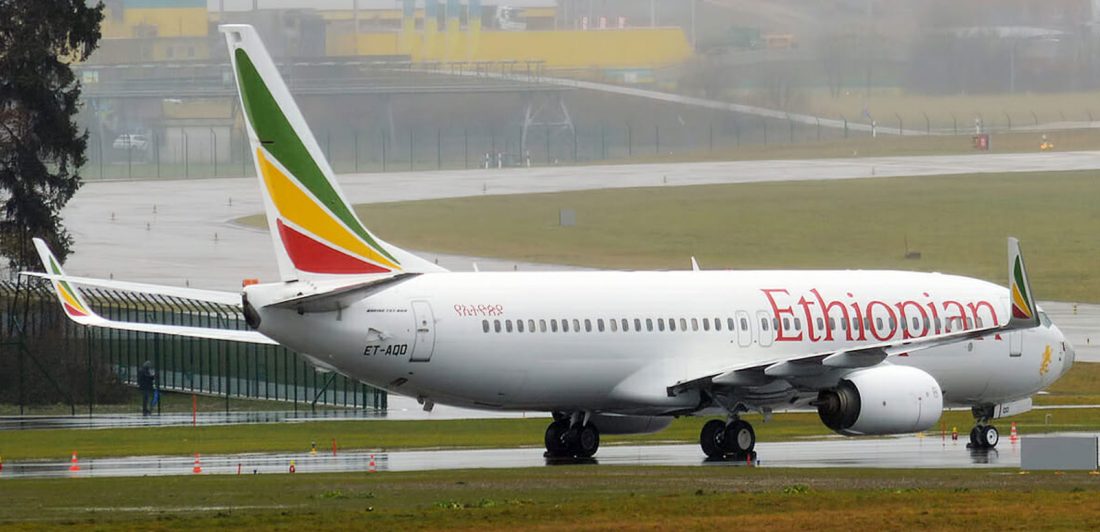3/13/2019 Update: President Donald Trump signed an order to ground the Max 8 in the U.S. and its airspace.
As a team of U.S. aviation experts arrived in Ethiopia to begin collecting data to determine the cause of the Ethiopian Airlines jet crash, the United Kingdom announced that it was grounding all Boeing 737 MAX 8 planes as a precautionary measure. So far, more than 40 countries have grounded the plane. But, both the U.S. FAA and Boeing continue to deny there is a serious enough issue that requires grounding.
On March 10, an Ethiopian Airlines plane crashed shortly after take-off—killing all 157 on board. The diverse mix of passengers included eight Americans.
The MAX 8 is the foremost jet of a new generation being manufactured and sold to many countries. However, the Ethiopian Airlines crash on Sunday became the second Max 8 to crash within five months. In October 2018, a Lion Air plane nosedived from the skies of Indonesia and into the Java Sea twelve minutes after take off. All 189 passenger and crew members on board the Lion Air flight were killed.
The United States has yet to ground any planes following the latest MAX 8 crash. However, former National Transportation Safety Board Chairman Jim Hall says both Boeing and the Federal Aviation Administration (FAA) should ground the U.S. fleet of 737 MAX 8 jets.
While every country has a civil aviation authority that its own authority to ground planes, a decision to ground these jets from the FAA would have a tremendous influence on other countries.
Currently, there are 74 MAX 8s flying in the United States and 387 flying globally. With 4,661 more of these planes on order, experts are warning that its vital to find out what’s wrong with the planes before they return to the sky.
What is the 737 MAX 8?
The 737 MAX is the newest version of the 737, the best-selling airliner of all time. In terms of aviation transportation, the MAX 8 is a relatively new jet. It has been in flying for a little over two years. Since its 2017 debut, dozens of airlines have embraced the MAX 8 for its fuel efficiency and utility for both short and medium-haul flights.
The plane retails from $100 million to $135 million, however airlines typically get deep discounts. Currently, 69 airlines fly the 737 MAX 8 globally with 54 of those airlines operating in the U.S. This includes airline titans Southwest and American Airlines.
What caused the Ethiopian Airlines crash?
It’s too early to know the exact cause of the Ethiopian Airline crash. However, what we currently know is that moments after takeoff, the senior pilot issued a distress call. He was told to return to the airport, but all contact was lost shortly after.
A witness said smoke was coming from the rear of the plane before it hit the ground. Additionally, the witness told the Associated Press that the plane rotated twice before crashing and exploding.
Similarities to the Indonesian Lion Air crash
The Lion Air plane that crashed 12 minutes after takeoff in Indonesia is the same style jet that crashed in Ethiopia over the weekend. While it is too soon to say that these planes went down for the same reasons, there is some evidence that the planes experienced similar problems. Both flights experienced drastic speed fluctuation during ascent and both pilots tried to return to the airport after takeoff.
According to reports, moments before the Lion Air crash, technical problems began occurring. The plane crashed moments after the pilot asked to return to the airport. Pilots struggled with the plane’s Maneuvering Characteristics Augmentation System (MCAS). The system repeatedly forced the plane’s nose down, despite pilot efforts to correct this.
Does the MAX 8 have a defective design?
When Boeing redesigned the 737, the size and placement of the aircraft’s engines altered how the jet handled in flight. For example, the MAX 8 tends to pitch or raise its nose in flight. But if a plane pitches too high, it risks stalling and crashing. Boeing was aware of this and designed an anti-stall system called the Maneuvering Characteristics Augmentation System (MCAS). This system is designed to stabilize the plane while in flight and automatically reduce the ‘pitch’ without pilot input.
However, pilots learned only after the Indonesia crash that this may be a flawed system.
The MCAS is fed data through synchronized devices located on the plane’s nose called Angle of Attack sensors. These sensors detect if the plane is pitching too high and adjusts the tail’s stabilizer—the horizontal part of the aircraft’s tail—to level out the plane. However, these sensors can fail and feed faulty or contradictory information to the MCAS. According to a bulletin issued by Boeing in November 2018, when this series of events occurs, it will force the jet into a nosedive.
Pilots can turn the system off. However, if or when the system suddenly activates, it can lead to pilot confusion. Further, according to The Air Current, the Maneuvering Characteristics Augmentation System was not mentioned in the flight crew operation manual. And pilots say they didn’t learn of the system until after the Indonesia crash.
The Ethiopia Air crash renews scrutiny of the MCAS system that began shortly after the Indonesian Lion Air Crash on October 28, 2018.
The Carlson Law Firm is Here for You
Losing a loved one in a plane crash can be an unexpected and total upheaval to your life. Airplane manufacturers and airlines have a duty to ensure that all aircraft are safe. These types of cases are time sensitive and require an attorney to get to work right away. Our team works diligently to collect and examine information that can help you hold negligent parties accountable.
If our team determines design or parts defect led to a crash, we can help you with your next steps. We believe every person who has been affected by negligence deserves justice. It is your right to seek legal help, and that is why we are here. Contact a Carlson Law Firm aviation attorney for a free consultation.





